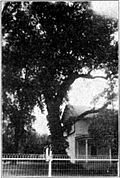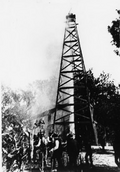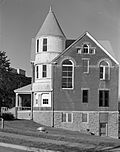List of National Historic Landmarks in Kansas facts for kids
Welcome to a list of amazing places in Kansas that are called National Historic Landmarks! These are special spots chosen by the U.S. government because they are super important to the history of our country. There are 26 of these landmarks right here in Kansas.
The National Historic Landmark program is run by the National Park Service. It helps us find and protect buildings, areas, objects, and other things that have a big meaning for the whole nation.
Kansas has 26 of these cool landmarks. They show us a lot about the state's past, like its military history and its frontier days. They also highlight Kansas's role in big movements like the Civil Rights Movement and the Progressive Movement. Let's explore some of these incredible places!
Kansas's National Historic Landmarks
These special places in Kansas tell important stories about the past. They include battlefields, old forts, and even a school that changed history. Each one helps us understand how Kansas and the United States grew and changed.
| Landmark name | Image | Date designated | Location | County | Description | |
|---|---|---|---|---|---|---|
| 1 | Black Jack Battlefield |
(#04000365) |
Baldwin City 38°45′42″N 95°07′50″W / 38.761667°N 95.130556°W |
Douglas | The Battle of Black Jack happened on June 2, 1856. It was a key moment in the "Bleeding Kansas" period, showing the growing conflict over slavery. This battle was an early step in John Brown's fight against slavery. | |
| 2 | Council Grove Historic District |
(#66000347) |
Council Grove 38°39′38″N 96°29′23″W / 38.660678°N 96.489672°W |
Morris | In 1825, the United States and the Osage Nation signed a treaty here. This agreement made sure that travelers on the Santa Fe Trail could pass safely through Osage lands. Council Grove was a perfect stopping point because it had water, food for animals, and wood. | |
| 3 | El Cuartelejo |
(#66000351) |
Scott City 38°40′41″N 100°54′51″W / 38.67813°N 100.91407°W |
Scott | This area has over 20 archeological sites, mostly from the Dismal River/Plains Apache culture (around 1650 to 1750 CE). The main site is a pueblo ruin. It was likely built by Taos Indians who sought safety with the Apache from the Spanish. It's the most northeastern pueblo ever found in the U.S. The site also shows early Spanish exploration in the Great Plains. | |
| 4 | Fort Larned |
(#66000107) |
Larned 38°10′25″N 99°11′56″W / 38.17361°N 99.19889°W |
Pawnee | From 1860 to 1878, this was the most important fort protecting the northern part of the Santa Fe Trail. After it was no longer needed, it became a private ranch. Today, it has been restored to look like it did in the 1860s. It's one of the best-preserved military posts from the mid-19th century in the western U.S. | |
| 5 | Fort Leavenworth |
(#66000346) |
Leavenworth 39°21′18″N 94°55′16″W / 39.35500°N 94.92111°W |
Leavenworth | This fort has been used by the United States Army since 1827. It was first built to protect travelers on the Santa Fe Trail. It played big roles in the Mexican and Civil Wars. In 1854, it even became the temporary capital of the Kansas Territory. | |
| 6 | Fort Scott |
(#66000106) |
Fort Scott 37°50′31″N 94°42′17″W / 37.8419633225°N 94.7047653434°W |
Bourbon | This fort was built in 1842 and closed in 1853. It first served as a frontier outpost along the "Permanent Indian Frontier". Later, during the Civil War, it became an important garrison. Many black troops were active and trained here during the Civil War. | |
| 7 | Haskell Institute |
(#66000342) |
Lawrence 38°56′23″N 95°13′58″W / 38.939722°N 95.232778°W |
Douglas | Haskell Institute, now Haskell Indian Nations University, is a historic school. It has played a vital role in the education of Native American students for many years. | |
| 8 | Hollenberg (Cottonwood) Pony Express Station |
(#66000352) |
Hanover 39°53′56″N 96°50′37″W / 39.8989718876°N 96.8435817529°W |
Washington | Built in 1858 by Gerat H. Hollenberg, this cabin was part of the Oregon and California Trails. It was also a stop for the Pony Express and the Butterfield Overland Mail. Hollenberg traded with travelers and provided services for the mail routes. The building is still in its original spot and looks much as it did. | |
| 9 | Lecompton Constitution Hall |
(#71000312) |
Lecompton 39°02′37″N 95°23′40″W / 39.0436775381°N 95.3944537582°W |
Douglas | Constitution Hall in Lecompton was a key place during the "Bleeding Kansas" period. Important meetings about Kansas becoming a state and the issue of slavery happened here. | |
| 10 | Lower Cimarron Spring |
(#66000344) |
Ulysses 37°23′54″N 101°22′15″W / 37.3983562°N 101.3707193°W |
Grant | Lower Cimarron Spring, also known as Wagon Bed Spring, was a crucial water source. It was a vital stop for travelers on the dry Cimarron Cutoff of the Santa Fe Trail. | |
| 11 | Marais des Cygnes Massacre Site |
(#71000317) |
Trading Post 38°16′53″N 94°37′16″W / 38.281389°N 94.62111°W |
Linn | The Marais des Cygnes Massacre Site marks a tragic event from 1858. During the "Bleeding Kansas" era, pro-slavery forces attacked and killed anti-slavery settlers here. | |
| 12 | Medicine Lodge Peace Treaty Site |
(#69000059) |
Medicine Lodge 37°15′55″N 98°35′35″W / 37.265406°N 98.593057°W |
Barber | The Medicine Lodge Peace Treaty Site is where important treaties were signed in 1867. The U.S. government and several Native American tribes, including the Cheyenne, Arapaho, Kiowa, Comanche, and Plains Apache, met here to try and establish peace. | |
| 13 | Carrie A. Nation House |
(#71000303) |
Medicine Lodge 37°16′32″N 98°34′55″W / 37.275620°N 98.581998°W |
Barber | This was the home of Carrie Nation, a famous activist. She was known for her strong beliefs and actions in the temperance movement, which aimed to stop the sale and consumption of alcohol. | |
| 14 | Nicodemus Historic District |
(#76000820) |
Nicodemus 39°23′40″N 99°37′01″W / 39.3944520°N 99.6170555°W |
Graham | The town of Nicodemus was founded by African Americans after the Civil War. It shows the brave spirit of formerly enslaved people who sought new lives. Established on homestead land in 1877, Nicodemus is the only remaining town from the "Exoduster" movement. This movement was led by Benjamin "Pap" Singleton, who helped found many colonies in Kansas. | |
| 15 | Norman No. 1 Oil Well |
(#74000846) |
Neodesha 37°24′53″N 95°40′23″W / 37.414722°N 95.673056°W |
Wilson | The Norman No. 1 Oil Well was the first successful oil well in Kansas. It started a new era of oil production in the state. | |
| 16 | Parker Carousel |
(#87000813) |
Abilene 38°54′34″N 97°12′31″W / 38.9095081378°N 97.2086375951°W |
Dickinson | This is one of only three carousels left from the Charles W. Parker Carousel Company, which was based in Abilene. It's a fun piece of history! | |
| 17 | Santa Fe Trail Remains |
(#66000343) |
Dodge City 37°47′31″N 100°11′49″W / 37.791944°N 100.196944°W |
Ford | This site preserves a two-mile section of the old wagon ruts from the Santa Fe Trail. You can still see the marks left by countless wagons traveling west. | |
| 18 | Shawnee Mission |
(#66000345) |
Fairway 39°01′59″N 94°37′27″W / 39.033134°N 94.62411°W |
Johnson | The Shawnee Methodist Mission was an important place for education and missionary work. It served as a school for Native American children and a center for the Shawnee people. | |
| 19 | Spring Hill Ranch |
(#08000828) |
Strong City 38°25′58″N 96°33′32″W / 38.432777°N 96.55889°W |
Chase | This ranch is the main part of the Tallgrass Prairie National Preserve. It helps protect one of the last remaining areas of tallgrass prairie in North America. | |
| 20 | Sumner Elementary School/ Monroe Elementary School |
(#87001283) |
Topeka 39°03′30″N 95°40′59″W / 39.058422°N 95.683156°W |
Shawnee | Sumner Elementary School was involved in the famous Supreme Court case Brown v. Board of Education. This case led to the end of segregation in public schools across the U.S. | |
| 21 | Tobias-Thompson Complex |
(#66000349) |
Geneseo |
Rice | The Tobias-Thompson Complex is an important archeological site. It provides clues about ancient human life and cultures in Kansas. | |
| 22 | Warkentin Farm |
(#74000839) |
Halstead 38°00′25″N 97°30′15″W / 38.006862°N 97.504265°W |
Harvey | This is the homestead of Bernhard Warkentin. He was important in bringing Mennonite immigrants to Kansas and helping them settle and farm the land. | |
| 23 | Western Branch, National Home for Disabled Volunteer Soldiers |
(#99000456) |
Leavenworth 39°16′43″N 94°53′29″W / 39.278611°N 94.89138°W |
Leavenworth | This site was a home for soldiers who were disabled after serving in the military. It provided care and support for veterans. | |
| 24 | William Allen White House |
(#71000318) |
Emporia 38°24′32″N 96°10′30″W / 38.409017°N 96.175044°W |
Lyon | This was the home of William Allen White, a very important journalist. He lived here from 1899 until 1944 and was a key figure in the Progressive movement. | |
| 25 | Whiteford (Price) Site |
(#66000350) |
Salina 38°51′36″N 97°31′58″W / 38.860000°N 97.532708°W |
Saline | The Whiteford (Price) Site is an archaeological site where people lived between 1000 and 1300 AD. It helps us learn about early human settlements in Kansas. | |
| 26 | Wyandotte National Burying Ground, Eliza Burton Conley Burial Site |
(#100000794) |
Kansas City 39°06′53″N 94°37′34″W / 39.114722°N 94.626111°W |
Wyandotte | This site includes the burial place of Eliza Burton Conley. She was a Wyandotte lawyer who fought to protect the Huron Cemetery from being sold. |
More to Explore


























